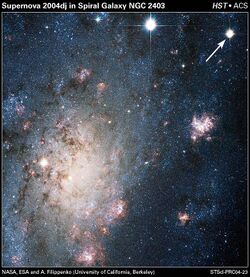Astronomy:SN 2004dj
From HandWiki
Short description: July 2004 supernova event in the constellation Camelopardalis
This article does not cite any external source. HandWiki requires at least one external source. See citing external sources. (December 2019) (Learn how and when to remove this template message) |
 | |
| Spectral class | II-P |
|---|---|
| Date | 31 July 2004 18:15 UTC |
| Constellation | Camelopardalis |
| Right ascension | 07h 37m 17.044s |
| Declination | +65° 35′ 57.84″ |
| Epoch | J2000.0 |
| Galactic coordinates | ? |
| Distance | about 11,000,000 light-years [1] |
| Remnant | Nebula |
| Host | NGC 2403 |
| Progenitor | Unknown star in compact cluster Sandage 96 |
| Progenitor type | Supergiant |
| Colour (B-V) | Unknown |
| Notable features | Light Curves |
| Peak apparent magnitude | +11.2 |
SN 2004dj was the brightest supernova since SN 1987A at the time of its discovery.
This Type II-P supernova was discovered by Koichi Itagaki, a Japan ese astronomer on July 31, 2004. At the time of its discovery, its apparent brightness was 11.2 visual magnitude; the discovery occurred after the supernova had reached its peak magnitude. The supernova's progenitor is a star in a young, compact star cluster in the galaxy NGC 2403, in Camelopardalis. The cluster had been cataloged as the 96th object in a list of luminous stars and clusters by Allan Sandage in 1984; the progenitor is therefore commonly referred to as Sandage 96. This cluster is easily visible in a Kitt Peak National Observatory image and appears starlike.
External links
- Light curves and spectra on the Open Supernova Catalog
- supernovae.net image collection
- NASA Astronomy Picture of the Day: Cropped and rotated HST photograph (7 September 2004)
- Bright Supernova page on 2004dj

